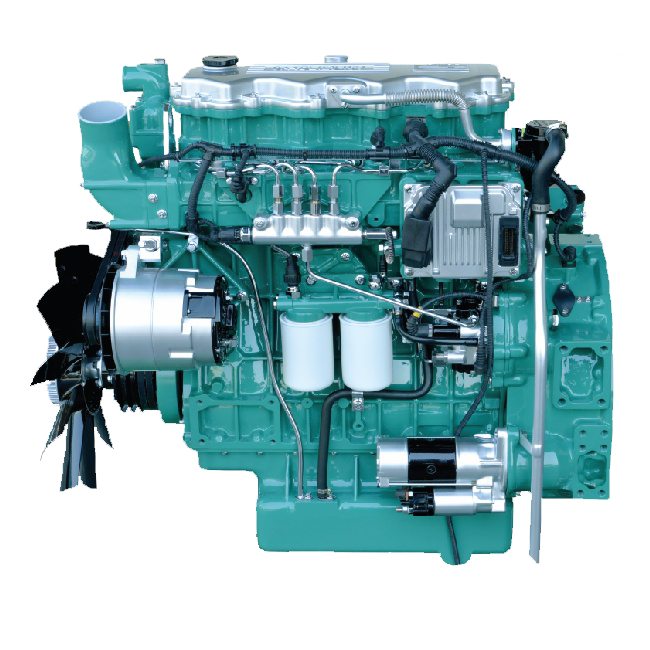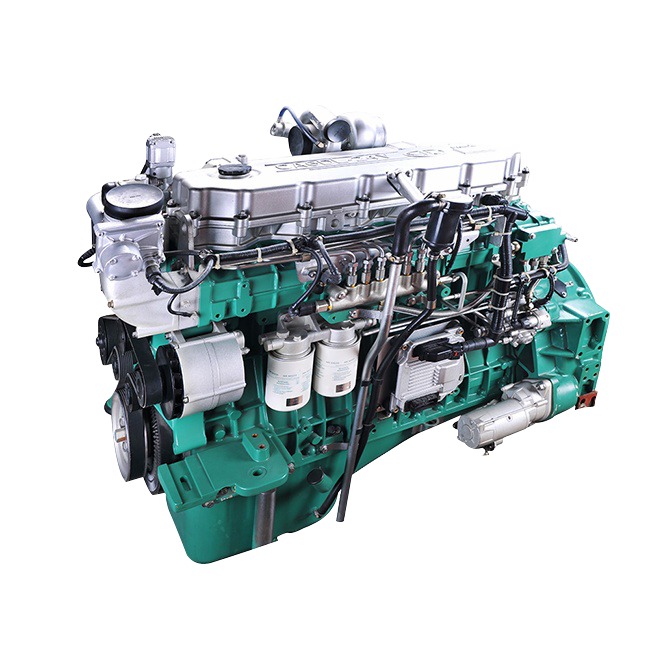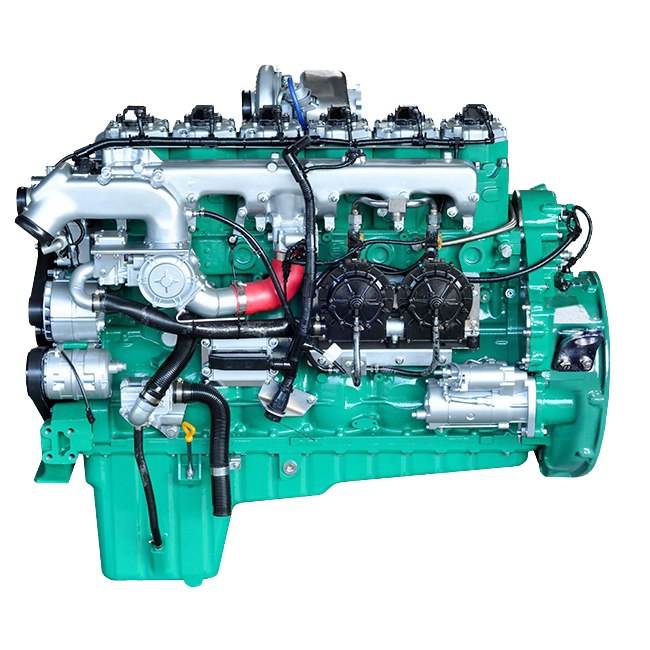12. 20, 2021
A diesel engine is a type of internal combustion engine that uses compression ignition to ignite the fuel as it is injected into the engine. It relies on compression for combustion, which results in increased fuel efficiency compared to other types of engines.

EURO V Vehicle diesel engine CA4DLD series
It is helpful to an understanding of how diesel engines work to compare the differences between a diesel engine and a gasoline engine. The main differences between a gasoline engine and a diesel engine are:
A gasoline engine takes a mixture of gas and air, compresses it, and ignites the mixture with a spark. A diesel engine takes air, compresses it, and then injects fuel into the compressed air. The heat of the compressed air ignites the fuel spontaneously. A diesel engine does not contain a spark plug.
A gasoline engine compresses at a ratio of 8:1 to 12:1, while a diesel engine compresses at a ratio of 14:1 to as high as 25:1. The higher compression ratio of the diesel engine leads to better efficiency.
Gasoline engines generally use either carburetion, in which the air and fuel are mixed long before the air enters the cylinder, or port fuel injection, in which the fuel is injected just prior to the intake stroke (outside the cylinder). In a gasoline engine, therefore, all of the fuel is loaded into the cylinder during the intake stroke and then compressed. The compression of the fuel/air mixture limits the compression ratio of the engine - if it compresses the air too much, the fuel/air mixture spontaneously ignites and causes knocking. Diesel engines use direct fuel injection i.e. diesel fuel is injected directly into the cylinder. A diesel engine compresses only air, so the compression ratio can be much higher. The higher the compression ratio, the more power generated.
Diesel fuel injectors, unlike gasoline injectors, must be able to withstand the temperature and pressure inside the cylinder and still deliver the fuel in a fine mist. To ensure that the mist is evenly distributed throughout the cylinder, some diesel engines are equipped with special induction valves or pre-combustion chambers. Newer diesel engines are equipped with high-pressure common rail fuel systems. See Diesel Fuel System Basics for more information on this type of fuel system.
Diesel engines may be equipped with a glow plug. When a diesel engine is cold, the compression process may not raise the air temperature high enough to ignite the fuel. The glow plug is an electrically heated wire that facilitates fuel ignition when the engine is cold. Glow plugs are typically found on small diesel engines. Gasoline engines do not require glow plugs as they do not rely on spontaneous combustion.


eURO V Vehicle diesel Engine CA6DL1 series GAS ENGINE CA6SN series
The main components of a diesel engine look like the components of a gasoline engine and perform the same job. However, because of the higher loads involved, diesel engine components must be stronger than their gasoline engine counterparts.
Diesel engine blocks typically have much thicker walls than blocks designed for gasoline engines, and they have more supporting webs to provide additional strength and absorb stresses. In addition to being stronger, heavy-duty blocks are also more effective at reducing noise.
Pistons, connecting rods, crankshafts and bearing caps must be stronger than in gasoline engines. The design of the cylinder head described must be because the fuel injector is also due to its shape and very different combustion and vortex chamber.
Diesel engines work by four processes: intake, compression, combustion expansion, and exhaust, which form a work cycle. A diesel engine in which the piston goes through four processes to complete a work cycle is called a four-stroke diesel engine.
The first stroke - air intake, its task is to make the cylinder full of fresh air. When the intake stroke begins, the piston is located in the upper stop, the cylinder in the combustion chamber still have some exhaust gas.
When the crankshaft rotates the elbow, the connecting rod makes the piston from the upper stop point to the lower stop point to move, at the same time, the use of the crankshaft with the drive mechanism to open the intake valve. With the downward movement of the piston, the volume above the piston in the cylinder gradually increases: causing the air pressure in the cylinder is lower than the pressure in the intake tube, so the outside air is constantly filled into the cylinder.
Intake process in the cylinder gas pressure with the volume of the cylinder changes as shown in the animation. The vertical coordinate of the graph indicates the gas pressure P, the horizontal coordinate indicates the cylinder volume Vh (or the piston stroke S), the graph is called show work graph. The pressure curve in the graph indicates the diesel engine work, the cylinder gas pressure changes in the law. From the soil we can see the beginning of the intake, due to the presence of residual exhaust gas, so slightly higher than the atmospheric pressure P0. In the intake process due to air through the intake pipe and intake valve flow resistance, so the gas pressure of the intake stroke is lower than the atmospheric pressure, the value of 0.085 to 0.095MPa, in the whole intake process, the cylinder gas pressure remains more or less the same.
When the piston downward movement close to the lower stop, the airflow into the cylinder still has a very high speed, inertia is very large, in order to use the inertia of the airflow to improve the amount of inflation, the intake valve in the piston after the lower stop before closing. Although the piston up at this time, but due to the inertia of the airflow, the gas can still fill the cylinder.
The second stroke--compression. Compression when the piston from the lower stop point between the upper stop point movement, the function of this stroke are two, one is to improve the temperature of the air, for the fuel to prepare for their own fire: two is to create the conditions for gas expansion work. When the piston goes up, the intake valve is closed, the air in the cylinder is compressed, with the volume of the continuous fine, the pressure and temperature of the air is rising, the pressure and humidity of the end of compression and the degree of compression of the air, that is, with the compression ratio, the general pressure and temperature of the end of compression: Pc = 4 to 8MPa, Tc = 750 to 950K.
The self-ignition temperature of diesel fuel is about 543-563K, the temperature of the end of compression is much higher than the temperature of diesel fuel self-ignition, enough to ensure that the fuel injected into the cylinder self-firing combustion.
Sprayed into the cylinder of diesel fuel, not immediately after the fire, and after the physical and chemical changes before the fire, this time about 0.001 to 0.005 seconds, called the fire delay period. Therefore, to turn the crank to the upper stop before 10 to 35 ° crank angle when the start of the atomized fuel sprayed into the cylinder, and make the crank in the upper stop after 5 to 10 °, in the combustion chamber to reach the highest combustion pressure, forcing the piston downward movement.
The third stroke - combustion expansion. At the beginning of this stroke, most of the fuel injected into the combustion chamber is burned. Combustion gives off a lot of heat, so the pressure and temperature of the gas will rise sharply, the piston under the action of high temperature and high pressure gas downward movement, and through the culm to make the crankshaft rotation, external work. So this stroke is also called work or work stroke.
With the piston down, the volume of the cylinder increases, the pressure of the gas drops, the work stroke in the piston line to the next stop, the exhaust valve open when the end.
The fourth stroke - exhaust. The function of the exhaust stroke is to exhaust the exhaust gas after expansion, in order to fill the fresh air, for the next cycle of air intake for preparation.
When the work stroke piston movement to the lower stop near, exhaust valve open up, the piston in the crankshaft and connecting rod drive, from the lower stop to the upper stop, and the exhaust gas out of the cylinder. Due to the existence of resistance to the exhaust system, so at the beginning of the exhaust stroke, the gas pressure in the cylinder plus than the atmospheric pressure of 0.025-0.035MPa, the temperature Tb = 1000 ~ 1200 K. In order to reduce the resistance of the piston movement when the exhaust, the exhaust valve opens before the lower stop.
Once the exhaust valve is opened, with a certain pressure of gas immediately rushed out of the cylinder, the cylinder pressure drops rapidly, so that when the piston moves upward, the cylinder exhaust gas relies on the piston upward to discharge. In order to use the exhaust airflow inertia to make the exhaust gas discharge clean, the exhaust valve in the upper stop point before closing
Actively responding to the spirit of President Xi Jinping's speech when inspecting FAW, we will build up the national automobile brand! the main products of diesel engines, gas engines, moving parts and remanufactured product and common rail systems. if need welcome to contact us !
الصفحة القادمة
هاتف: تحويلة.8356+86 510 8501 4990
تجمهر.: +86 13914166873
الفاكس: +86 510 8599 7974
بريد إلكتروني: faw_fawde@sina.com
عنوان: 98 # Yongle East Road، Wuxi، Jiangsu، CHINAw